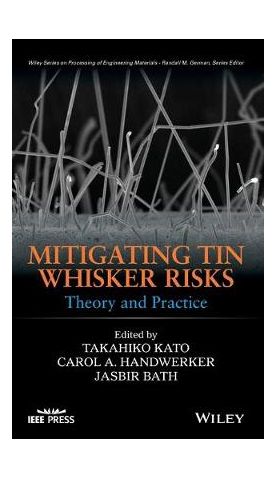אנו משתמשים ב-Cookies כדי לשפר את החוויה שלך. כדי לקיים ההנחיה החדשה של e-Privacy, עלינו לבקש את הסכמתך להגדיר את ה-Cookies. קבלת מידע נוסף.
757.00 ₪
Mitigating Tin Whisker Risks - Theory and Practice
757.00 ₪
ISBN13
9780470907238
יצא לאור ב
New York
זמן אספקה
21 ימי עסקים
עמודים
272
פורמט
Hardback
תאריך יציאה לאור
8 ביולי 2016
שם סדרה
Wiley Series on Processing of Engineering Materials
Discusses the growth mechanisms of tin whiskers and the effective mitigation strategies necessary to reduce whisker growth risks This book covers key tin whisker topics, ranging from fundamental science to practical mitigation strategies.
Discusses the growth mechanisms of tin whiskers and the effective mitigation strategies necessary to reduce whisker growth risks This book covers key tin whisker topics, ranging from fundamental science to practical mitigation strategies. The text begins with a review of the characteristic properties of local microstructures around whisker and hillock grains to identify why these particular grains and locations become predisposed to forming whiskers and hillocks. The book discusses the basic properties of tin-based alloy finishes and the effects of various alloying elements on whisker formation, with a focus on potential mechanisms for whisker suppression or enhancement for each element. Tin whisker risk mitigation strategies for each tier of the supply chain for high reliability electronic systems are also described.
* Discusses whisker formation factors including surface grain geometry, crystallographic orientation-dependent surface grain boundary structure, and the localization of elastic strain/strain energy density distribution * Examines how whiskers and hillocks evolve in time through real-time studies of whisker growth with the scanning electron microscope/focused ion beaming milling (SEM/FIB) * Covers characterization methods of tin and tin-based alloy finishes such as transmission electron microscopy (TEM), scanning electron microscopy (SEM), and electron backscatter diffraction (EBSD) * Reviews theories of mechanically-induced tin whiskers with case studies using pure tin and other lead-free finishes shown to evaluate the pressure-induced tin whiskers Mitigating Tin Whisker Risks: Theory and Practice is intended for the broader electronic packaging and manufacturing community including: manufacturing engineers, packaging development engineers, as well as engineers and researchers in high reliability industries.
| עמודים | 272 |
|---|---|
| פורמט | Hardback |
| ISBN10 | 0470907231 |
| יצא לאור ב | New York |
| תאריך יציאה לאור | 8 ביולי 2016 |
| תוכן עניינים | List of Contributors ix Introduction xi 1 A Predictive Model forWhisker Formation Based on Local Microstructure and Grain Boundary Properties 1 Pylin Sarobol, Ying Wang, Wei-Hsun Chen, Aaron E. Pedigo, John P. Koppes, John E. Blendell and Carol A. Handwerker 1.1 Introduction, 1 1.2 Characteristics of Whisker and Hillock Growth from Surface Grains, 3 1.3 Summary and Recommendations, 17 Acknowledgments, 18 References, 19 2 Major Driving Forces and Growth Mechanisms for TinWhiskers 21 Eric Chason and Nitin Jadhav 2.1 Introduction, 21 2.2 Understanding the Mechanisms Behind Imc-Induced Stress Evolution and Whisker Growth, 24 2.3 Relation of Stress to Whisker Growth, 34 2.4 Conclusions, 39 Acknowledgments, 40 References, 40 3 Approaches of Modeling and Simulation of Stresses in Sn Finishes 43 Peng Su and Min Ding 3.1 Introduction, 43 3.2 Constitutive Model, 44 3.3 Strain Energy Density, 46 3.4 Grain Orientation, 46 3.5 Finite Element Modeling of Triple-Grain Junction, 48 3.6 Finite Element Modeling of Sn Finish with Multiple Grains, 55 References, 66 4 Properties and Whisker Formation Behavior of Tin-Based Alloy Finishes 69 Takahiko Kato and Asao Nishimura 4.1 Introduction, 69 4.2 General Properties of Tin-based Alloy Finishes (Asao Nishimura), 70 4.3 Effect of Alloying Elements on Whisker Formation and Mitigation (Asao Nishimura), 75 4.4 Dependence of Whisker Propensity of Matte Tin Copper Finish on Copper Lead-Frame Material (Takahiko Kato), 89 4.5 Conclusions, 118 Acknowledgments, 118 References, 119 5 Characterization Techniques for Film Characteristics 125 Takahiko Kato and Yukiko Mizuguchi 5.1 Introduction, 125 5.2 TEM (Takahiko Kato), 125 5.3 SEM (Yukiko Mizuguchi), 140 5.4 EBSD (Yukiko Mizuguchi), 146 5.5 Conclusions, 154 Acknowledgments, 155 References, 155 6 Overview of Whisker-Mitigation Strategies for High-Reliability Electronic Systems 159 David Pinsky 6.1 Overview of Tin Whisker Risk Management, 159 6.2 Details of Tin Whisker Mitigation, 164 6.3 Managing Tin Whisker Risks at the System Level, 173 6.4 Control of Subcontractors and Suppliers, 183 6.5 Conclusions, 185 References, 185 7 Quantitative Assessment of Stress Relaxation in Tin Films by the Formation of Whiskers, Hillocks, and Other Surface Defects 187 Nicholas G. Clore, Dennis D. Fritz, Wei-Hsun Chen, Maureen E. Williams, John E. Blendell and Carol A. Handwerker 7.1 Introduction, 187 7.2 Surface-Defect Classification and Measurement Method, 189 7.3 Preparation and Storage Conditions of Electroplated Films on Substrates, 194 7.4 Surface Defect Formation as a Function of Tin Film Type, Substrate, and Storage Condition, 195 7.5 Conclusions, 209 Appendix, 209 Acknowledgments, 209 References, 213 8 Board Reflow Processes and their Effect on Tin Whisker Growth 215 Jasbir Bath 8.1 Introduction, 215 8.2 The Effect of Reflowed Components on Tin Whisker Growth in Terms of Grain Size and Grain Orientation Distribution, 215 8.3 Reflow Profiles and the Effect on Tin Whisker Growth, 216 8.4 Influence of Reflow Atmosphere and Flux on Tin Whisker Growth, 219 8.5 Effect of Solder Paste Volume on Component Tin Whisker Growth during Electronics Assembly, 220 8.6 Conclusions, 221 Acknowledgments, 222 References, 222 9 Mechanically Induced TinWhiskers 225 Tadahiro Shibutani and Michael Osterman 9.1 Introduction, 225 9.2 Overview of Mechanically Induced Tin Whisker Formation, 227 9.3 Theory, 228 9.4 Case Studies, 237 9.5 Conclusions, 245 References, 246 Index 249 |
| זמן אספקה | 21 ימי עסקים |



Login and Registration Form